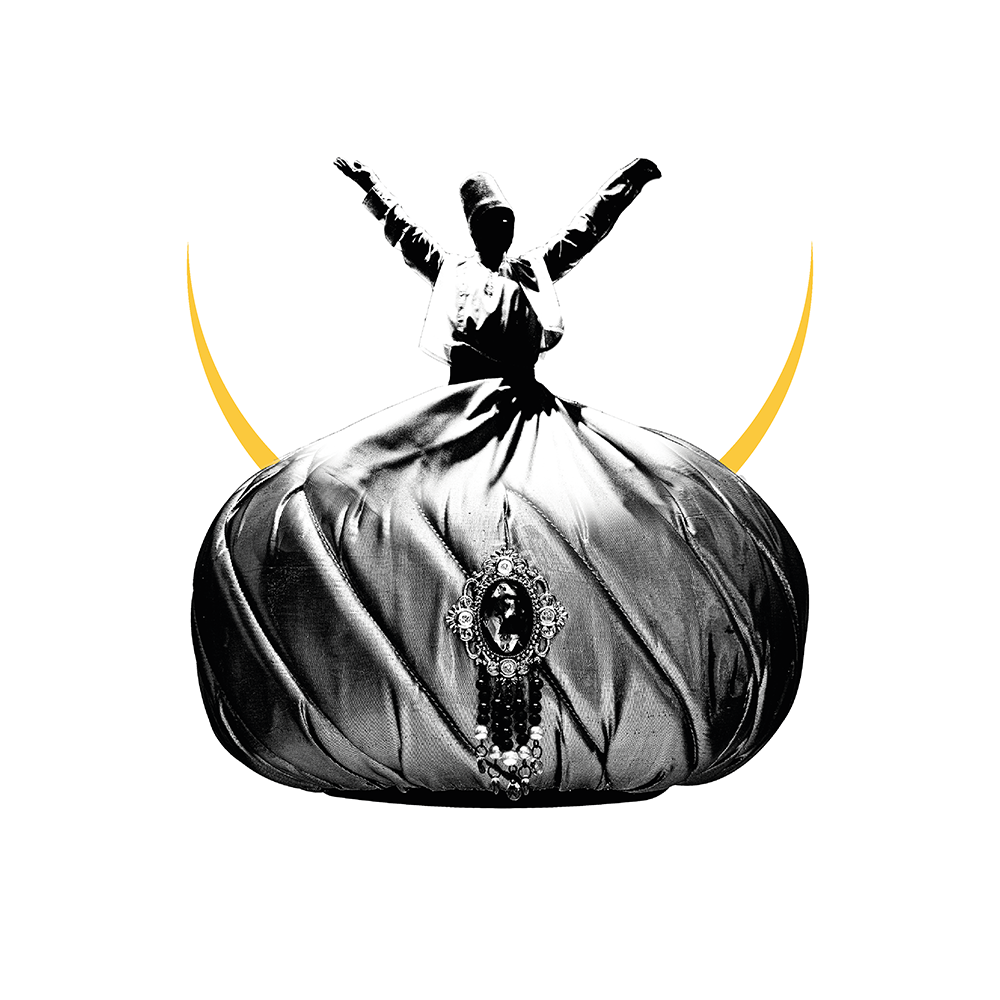
Hurufiers are intimate companions of "The Conqueror"
Hurufiers are intimate companions
of "The Conqueror"
by harboring their founder, "Tabrizi"
They restricted their communication with Allah verbally.

Bektashi Order
The Bektashi Order is considered one of the most important Sufi orders in the Ottoman Empire because of its official effect on it, especially as it was the patron of the Janissary army, as the Janissaries were associated with the Bektashiyya and its doctorine, so that their camps were filled with the guiding Sheikhs of the Bektashi orders. Moreover, it was known in Ottoman history that the Janissary army was under the control of The Bektashiyya and its directives, influenced and obeyed it more than they obeyed the Ottoman sultans, accordingly, the sultans harmonized with the Bektasiyya, considering the support it represented among the ranks of the Janissaries. This order was founded by Haji Bektash, who lived during the second half of the thirteenth century AD in Anatolia.
Reference:
Khalil Inalcik, History of the Ottoman Empire (Beirut: Dar Al-Madar Al-Islami, 2002).
The Sufi philosophy of pantheism
It is known as federalism, and the philosophy of pantheism is summarized in saying that Allah and nature are one reality, and Allah is the true existence, and they depict Allah with the creatures around them, while all that is material in creatures is nothing but an expression to the existence of Allah, otherwise materialities have no existence by itself. Among the most prominent people who believe in it and revived it in Islamic history are Muhyiddin Ibn Arabi, Ibn Al-Farid, and others who were influenced by Neoplatonist philosophy and the philosophy of the Stoics. Sunni scholars considered them as heretics, and those who believe in their words are disbelievers.
Reference:
Ahmad Al-Qusayr, The Sufism's Doctrine of the Hidden Pantheism (Riyadh: Al-Rashed Library, 2003).
Qalandariyya
It is considered one of the orders of Khorasani origin, and it spread after it was founded by Jamal Al-Din Al-Sawi in 463 AH / 1070 AD, and reached Iraq, Syria, Egypt, India and Anatolia, where it faced a violent attack by the Sunni Sufi orders because of its strange and suspicious rituals, as well as what The Qalandarians used to follow; such as disgusting pornography. Consequently, they aspired to celibacy, poverty and begging, as they roamed the Anatolian cities in their strange costumes, shaved heads with their mustaches and eyebrows, carrying their own flags while beating the drums, and the most prominent things that made Anatolian society detest them directly were that they were deliberately calling to rebel against social and moral systems.
Reference:
Muhammad Cobrieli, The rise of the Ottoman Empire, translated by Ahmad Al-Saeed (Cairo: Dar Al-Kateb Al-Arabi, 1967).
Ibn Arabi
638-560 A.H. / 1240-1165 A.D.
Abu Bakr Muhammad bin Ali bin Arabi Al-Taie, he was born in Murcia in Andalusia, was one of the first people to elaborate on the philosophy of pantheism, and among his views is the unity of the essence of religions and does not differentiate between religions and worships that lead to Allah in any religion. He also has a set of prophecies circulating in Ottoman history, the most prominent of which is that he gave a description of the conqueror of Constantinople, and determined its year, so it is said that Salim built a dome on his grave and made it a shrine in the Levant.
Reference:
Saad Rostom, The Sects and the Islamic Schools, 3rd Edition (Damascus: Al-Awael for Publishing and Distribution, 2005).


The official "Bektashiyya" of the Ottomans
It sanctioned "polytheism"
in identification with modern Islam
Rituals of Christianity were embraced by the Sultanate's official Sufi method.

Al- Batiniyy is still present in the Turkish popular memory with its beliefs, visions, and philosophy.


Through the Political Sufism
Ottoman "Darkness"
Lasted Centuries of History
Each Sultan has his own aberrant spiritual inclination.

Jalal al-Din al-Rumi
672 - 604 AH / 1273 - 1207 AD
Mohammed bin Mohammed bin Hussein Al-Balkhi, he was called Jalal al-Din Rumi, the Mawlawyia Tariqah was attributed to him. He was known for his poetry and he had written many books, the most known of them was Masnawi. He had views supporting existentialism; some called them Rumi's ideas of existentialism.
Reference:
Mustafa Ghaleb, Jalal al-Din al-Rumi (Beirut: The Ezzedine Foundation, 1982).
Zinnia Tariqah
It was one of the influential Sufi Tariqahs during one of the intermediate periods of Ottoman history in Anatolia. It was Founded by Zain Al-Din Al-Khawafi (died: 838 AH / 1435 AD), born in Khurasan, and he wrote a number of books, most notably: The Message of the Divine Commandments, the Zennia Wirds, the approach of Rashad, i. e. the right way.
Reference:
Ronnie Ellie Alpha, Encyclopedia of Philosophers (Beirut: Dar al Kotob al ilmiyah, 1991).
Permian Tariqah
It was one of the Sufi Tariqahs that appeared in Anatolia during the period of general unrest in 804 AH / 1402 AD, while Tamerlane invaded and overthrow the Ottomans for a period of time. It was founded by Haji Bayram (died: 833 AH / 1430 AD) near Ankara. As during he was calling for his Tariqah, the state questioned him. Therefore, he was asked to appear before Murad II, who pardoned him after he reassured that his call and his Tariqah. As well as some of Perm's students were exempted from taxes by Murad II to help him expanding the Tariqah. His followers were divided into two groups: The first one preserved Sunni Islam through Sufism, and among the Sheikhs of this group was Aqa Shams al-Din, the professor of Muhammad al-Fatih and his closest Sheikh, and the second group radicalized its views that were closest to Shiism and unity of existence.
Reference:
Khalil Inalcik, History of the Ottoman State (Beirut: Dar al-Madar al-Islami, 2002).
Naqshbandi Tariqah
It came out of Central Asia and moved to Anatolia in the late fifteenth Georgian century. It is affiliated with Muhammad Bahaa al-Din Naqshband. It entered into Anatolia in two times, first one was through one of Bukhara Sheikhs, and then the second one according to the radical Indian Tariqah. It is one of the closest Sufi Tariqahs to the beliefs of Ahlu Sunna Wal Jama'a, i. e. the Sunnis; since its followers are among the most devoted Sufis to preserve the religious duties of prayer and fasting, unlike some other Sufi Tariqahs.
Reference:
Bernard Lewis, Istanbul and the Islamic Caliphate Civilization, translated by: Sayed Radwan, 2nd edition (Riyadh: Saudi Publishing House, 1982).
Khuluthiyya Tariqah
It was founded by Akhiy Youssef Al-khuluthi in the late thirteenth Georgian century. It was one of the Tariqahs that were preserving the appearances of Sunnis, like some other Tariqahs.
Reference:
Muhammad Cobrieli, the Establishment of the Ottoman State, translated by: Ahmed Al-Saeed (Cairo: Dar AlKatib Al Arabi, 1967).
Al-Jarrahia Tariqah
It was called Helvetia, and It was said that it branched off from khuluthiyya Tariqah. It was founded by Nur al-Din al-Jarahi (1133 - 1089 AH / 1721 - 1678 AD) in Anatolia, in addition to that it is one of the most widespread Sufi Tariqahs in the West Counties.
Reference:
Aziz Idrissi, Sufism in the United States of America (Beirut: Dar al Kotob al ilmiyah, 2013).
By deception, they invoked Islamic symbols to justify their deviations.







